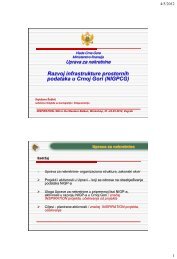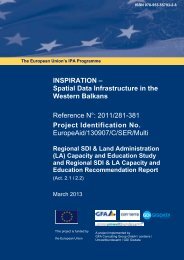Introduction to Unified Modeling Language (UML) - INSPIRATION
Introduction to Unified Modeling Language (UML) - INSPIRATION
Introduction to Unified Modeling Language (UML) - INSPIRATION
Create successful ePaper yourself
Turn your PDF publications into a flip-book with our unique Google optimized e-Paper software.
<strong>INSPIRATION</strong> – Spatial Data Infrastructure in the Western Balkans<br />
<strong>Introduction</strong> <strong>to</strong> <strong>Unified</strong> <strong>Modeling</strong><br />
<strong>Language</strong> (<strong>UML</strong>)<br />
3rd <strong>INSPIRATION</strong> Training<br />
December 4-5, 2012<br />
A multi-country project funded by the<br />
European Union and implemented by
Content<br />
• Basic introduction<br />
• Models<br />
• <strong>UML</strong><br />
• Diagrams<br />
• Exercises & Examples<br />
• Class diagram
Scope<br />
• Basic knowledge of <strong>UML</strong><br />
<strong>Introduction</strong><br />
of modelling<br />
and <strong>UML</strong><br />
Class model<br />
introduction<br />
& Exercises<br />
INSPIRE Data<br />
Specification<br />
on Cadastre
<strong>UML</strong> Background<br />
What are models?
<strong>UML</strong> Background<br />
What are models?<br />
• A complete description of a system from a<br />
particular perspective<br />
• Simplification of reality
Why models?<br />
• <strong>Modeling</strong> achieves four aims:<br />
• Helps you <strong>to</strong> visualize a system as you want it <strong>to</strong> be.<br />
• Permits you <strong>to</strong> specify the structure or behavior of a<br />
system.<br />
• Gives you a template that guides you in constructing a<br />
system.<br />
• Documents the decisions you have made.<br />
• You build models of complex systems because you<br />
cannot comprehend such a system in its entirety.<br />
• You build models <strong>to</strong> better understand the system<br />
you are developing.
Four Principles of <strong>Modeling</strong><br />
• The model you choose influences how the<br />
problem is attacked.<br />
Process Model<br />
Deployment Model<br />
Design Model<br />
• Every model may be expressed at different levels<br />
of precision.<br />
• The best models are connected <strong>to</strong> reality.<br />
• No single model is sufficient.
<strong>UML</strong> Background<br />
What is <strong>UML</strong>?<br />
The OMG specification states:<br />
?<br />
"The <strong>Unified</strong> <strong>Modeling</strong> <strong>Language</strong> (<strong>UML</strong>) is a graphical<br />
language for visualizing, specifying, constructing, and<br />
documenting the artifacts of a software-intensive system.<br />
The <strong>UML</strong> offers a standard way <strong>to</strong> write a system's<br />
blueprints, including conceptual things such as business<br />
processes and system functions as well as concrete things<br />
such as programming language statements, database<br />
schemas, and reusable software components."
<strong>UML</strong> Background<br />
What is <strong>UML</strong>?<br />
• <strong>UML</strong> is a language (<strong>Unified</strong> <strong>Modeling</strong><br />
<strong>Language</strong>) for models<br />
• technical and graphical specification<br />
• Graphic notation <strong>to</strong> visualize models<br />
• Not a method or procedure<br />
• Managed and created by the Object<br />
Management Group
<strong>UML</strong> Background<br />
• The <strong>UML</strong> is a language for<br />
• Visualizing<br />
• Specifying<br />
• Constructing<br />
• Documenting<br />
the artifacts of a software-intensive system.<br />
• The <strong>Unified</strong> Modelling <strong>Language</strong> (<strong>UML</strong>) is an<br />
industry standard for object oriented design<br />
notation, supported by the Object Management<br />
Group (OMG).
<strong>Language</strong> for Visualizing<br />
• Communicating conceptual models<br />
<strong>to</strong> others is prone <strong>to</strong> error unless<br />
everyone involved speaks the same<br />
language.<br />
• There are things about a software<br />
system you can’t understand unless<br />
you build models.<br />
• An explicit model facilitates communication.
<strong>Language</strong> for Specifying<br />
• The <strong>UML</strong> builds models that are precise,<br />
unambiguous, and complete.
<strong>Language</strong> for Constructing<br />
• <strong>UML</strong> models can be directly connected <strong>to</strong> a<br />
variety of programming languages.<br />
• Maps <strong>to</strong> Java, C++, Visual Basic, and so on<br />
• Tables in a RDBMS or persistent s<strong>to</strong>re in an<br />
OODBMS<br />
• Permits forward engineering<br />
• Permits reverse engineering
ƯÁ¤¹®¼¿¡ ´ëÇÑ º¸±â¸¦<br />
»ç¿ëÀÚ°¡ ¿äûÇÑ´Ù.<br />
ÈÀÏ°ü¸®ÀÚ´Â Àоî¿Â<br />
¹®¼ÀÇ Á¤º¸¸¦ ÇØ´ç ¹®¼<br />
°´Ã¼¿¡ ¼³Á¤À» ¿äûÇÑ´Ù.<br />
È¸é °´Ã¼´Â ÀоîµéÀÎ<br />
°´Ã¼µé¿¡ ´ëÇØ À̸§º°·Î<br />
Á¤·ÄÀ» ½ÃÄÑ È¸é¿¡<br />
º¸¿©ÁØ´Ù.<br />
1: Doc view request ( )<br />
9: sortByName ( )<br />
2: fetchDoc( )<br />
3: create ( )<br />
6: fillDocument ( )<br />
4: create ( )<br />
8: fillFile ( )<br />
5: readDoc ( )<br />
7: readFile ( )<br />
ºÐ»ê ȯ°æÀÇ Çϵå¿þ¾î¹× ³×Æ®¿÷À¸·ÎÀÇ Á¤º¸ ½Ã½ºÅÛ ¿¬°á ¸ðµ¨<br />
- À©µµ¿ì 95 : ŬóÀ̾ðÆ®<br />
- À©µµ¿ì NT: ÀÀ¿ë¼¹ö<br />
- À¯´Ð½º ¸Ó½Å: ÀÀ¿ë ¼¹ö ¹× µ¥ÀÌŸ ¼¹ö, Åë½Å ¼¹ö<br />
- IBM ¸ÞÀÎÇÁ·¹ÀÓ: µ¥ÀÌŸ ¼¹ö, Åë½Å ¼¹ö<br />
Window95<br />
¹®¼°ü¸®<br />
ŬóÀ̾ðÆ®.EXE<br />
FileMgr<br />
fetchDoc( )<br />
Reposi<strong>to</strong>ry<br />
(from Persistence)<br />
rep<br />
name : char * = 0<br />
readDoc( )<br />
readFile( )<br />
Windows<br />
NT<br />
sortByName( )<br />
Windows<br />
NT<br />
¹®¼°ü¸® ¿£Áø.EXE<br />
FileList<br />
add( )<br />
delete( )<br />
read( )<br />
File<br />
Windows95<br />
DocumentList<br />
add( )<br />
IBM<br />
Mainframe<br />
µ¥ÀÌŸº£À̽º¼¹ö<br />
delete( )<br />
1<br />
fList<br />
Solaris<br />
ÀÀ¿ë¼¹ö.EXE<br />
GrpFile<br />
read( )<br />
open( )<br />
create( )<br />
fillFile( )<br />
get( )<br />
name : int<br />
docid : int<br />
open( )<br />
close( )<br />
read( )<br />
Document<br />
numField : int<br />
sortFileList( )<br />
create( )<br />
Windows95<br />
¹®¼°ü¸® ¾ÖÇø´<br />
fillDocument( )<br />
Alpha<br />
UNIX<br />
code..<br />
read() fill the<br />
<strong>Language</strong> for Documenting<br />
• The <strong>UML</strong> addresses documentation of system architecture,<br />
requirements, tests, project planning, and release management.<br />
Use Case Diagram<br />
Deployment Diagram<br />
Use Case 1<br />
Ac<strong>to</strong>r A<br />
Use Case 2<br />
Ac<strong>to</strong>r B<br />
Use Case 3<br />
user<br />
mainWnd fileMgr :<br />
FileMgr<br />
document :<br />
Document<br />
gFile<br />
reposi<strong>to</strong>ry<br />
Sequence Diagram<br />
Class Diagram
His<strong>to</strong>ry of the <strong>UML</strong>
Diagrams<br />
• Diagrams graphically depict a view of a part of your<br />
model.<br />
• Different diagrams represent different views of the<br />
system that you are developing.<br />
• A model element will appear on one or more diagrams.
<strong>UML</strong> Diagrams<br />
• <strong>UML</strong> 2.2<br />
• 14 different types of diagrams<br />
• 2 different groups<br />
• Behavior & Interaction models<br />
• Structural models
<strong>UML</strong> Diagrams
Key Diagrams in <strong>UML</strong><br />
Requirements<br />
Use Case Diagrams<br />
System Structure<br />
System Behaviour<br />
Class Diagrams<br />
Collaboration Diagrams<br />
Interaction Diagrams<br />
Activity Diagrams<br />
State Charts
Different diagrams of system<br />
for different people<br />
Logical View<br />
Implementation View<br />
Analysts/Designers<br />
Structure<br />
Use-Case View<br />
End-user<br />
Functionality<br />
Programmers<br />
Software management<br />
Process View<br />
Deployment View<br />
System integra<strong>to</strong>rs<br />
Performance, scalability, throughput<br />
System engineering<br />
System <strong>to</strong>pology, delivery,<br />
installation, communication
What is a Use-Case Model?<br />
A use-case model:<br />
• Is a model of a system’s intended functions and its<br />
environment<br />
• Serves as a contract between the cus<strong>to</strong>mer and the<br />
developers<br />
• Contains the following diagrams:<br />
• Use case: Shows a set of use cases and ac<strong>to</strong>rs and their<br />
relationships<br />
• Activity: Shows the flow of events within a use case<br />
• Sequence: Shows how a use case will be implemented in terms of<br />
collaborating objects
Use-Case Diagram<br />
View Report Card<br />
Student<br />
Register for Courses<br />
Login<br />
Course Catalog<br />
Registrar<br />
Maintain Professor<br />
Information<br />
Maintain Student<br />
Information<br />
Professor<br />
Select Courses <strong>to</strong><br />
Teach<br />
Submit Grades<br />
Close Registration<br />
Billing System
Activity Diagram<br />
Action<br />
A step in the flow of events<br />
Decision<br />
Flows split based on a guard<br />
condition<br />
Fork<br />
Beginning of concurrent flows<br />
Join<br />
End of concurrent flow<br />
Flow<br />
Show the sequence of<br />
activities
Activity Diagram (Example)<br />
Concurrent<br />
Threads<br />
Guard<br />
Condition<br />
Check<br />
Schedule<br />
Select Course<br />
[ add course ]<br />
[ delete course ]<br />
Check<br />
Pre-requisites<br />
[ checks completed ] [ checks failed ]<br />
Decision<br />
Delete Course<br />
Activity/Action<br />
Synchronization<br />
Bar (Fork)<br />
Synchronization<br />
Bar (Join)<br />
Assign <strong>to</strong><br />
Course<br />
Resolve<br />
Conflicts<br />
Transition<br />
Update<br />
Schedule
What is a Design Model?<br />
A design model:<br />
• Describes the realization of use cases in terms of design<br />
elements<br />
• Describes the design of the application<br />
• Contains the following diagrams:<br />
• Class: Shows <strong>UML</strong> classes and relationships<br />
• Component: Shows the structure of elements in the<br />
implementation model<br />
• Communication and Sequence: Show how objects and classes<br />
interact<br />
• State Machine: Shows event-driven behavior
Class Diagram<br />
• Class diagrams show the static structure of the<br />
model resp. system<br />
• Classes<br />
• Attributes<br />
• Relationships <strong>to</strong> other classes<br />
• Class diagrams do not show temporal<br />
information<br />
• INSPIRE data specifications
Class Diagram<br />
Class<br />
A description of a set<br />
of objects<br />
Attribute<br />
Named property of<br />
a class<br />
Operation<br />
Class behavior<br />
Generalization<br />
Shows an inheritance<br />
relationship<br />
Aggregation<br />
Represents a part-whole<br />
relationship
Sequence Diagram<br />
• used <strong>to</strong> show how objects interact <strong>to</strong><br />
perform the behavior of all or part of a use<br />
case as part of a use-case realization
Sequence Diagram<br />
Object/Class<br />
Shows the<br />
object/class involved<br />
in the interaction<br />
Messages<br />
Show data exchanged<br />
between objects<br />
Execution Occurrence<br />
Shows object executing<br />
Lifeline<br />
Shows the life of the object
Sequence Diagram<br />
(Example)<br />
:RegisterForCoursesForm :RegistrationController SWTSU Catalog :<br />
CourseCatalogSystem<br />
: Student : Course Catalog<br />
1: create schedule( )<br />
2: get course offerings( )<br />
3: get course offerings(for Semester)<br />
5: display course offerings( )<br />
4: get course offerings( )<br />
6: display blank schedule( )<br />
ref<br />
Select Offerings
Sequence Diagram<br />
Combined Fragments<br />
Interaction Use (ref)<br />
References another interaction<br />
Optional Fragment<br />
(opt)<br />
Executed if guard condition<br />
evaluates <strong>to</strong> true<br />
Loop (loop)<br />
Executed as long as the first<br />
guard condition<br />
evaluates <strong>to</strong> true
Communication Diagram<br />
• Collaboration diagram<br />
• provide another way <strong>to</strong> show how objects<br />
interact <strong>to</strong> perform the behavior of a<br />
particular use case or a part of a use case.<br />
Where sequence diagrams emphasize the<br />
interactions of objects over time,<br />
communication diagrams are designed <strong>to</strong><br />
emphasize the relationships between objects
Communication Diagram<br />
Object/Class<br />
Shows the<br />
object/class involved<br />
in the interaction<br />
Message<br />
Shows data<br />
exchanged<br />
between objects
Communication Diagram<br />
Messages<br />
5: display course offerings( )<br />
6: display blank schedule( )<br />
1: create schedule( )<br />
: RegisterForCoursesForm<br />
Links<br />
: Course Catalog<br />
: Student<br />
2: get course offerings( )<br />
4: get course offerings( )<br />
3: get course offerings(forSemester)<br />
: RegistrationController : CourseCatalogSystem
Component Diagram<br />
• It shows the runtime structure of the<br />
system at the level of software<br />
components. Components are the modular<br />
parts of the system and are made up of<br />
groups of related objects that are hidden<br />
behind an external interface.
Component Diagram<br />
Component<br />
Modular parts of the system<br />
Class<br />
Included <strong>to</strong> show implementation<br />
relationships.
Deployment Diagram<br />
• Deployment diagrams show the<br />
deployment architecture of the system,<br />
that is, which of the system’s software<br />
artifacts reside on which pieces of<br />
hardware.
Deployment Diagram<br />
Artifact<br />
Represents a physical file<br />
Owned Element<br />
Relationship<br />
Shows another way of<br />
showing nested elements<br />
Node<br />
Represents a<br />
physical machine
How Many Diagrams?<br />
• Depends:<br />
• You use diagrams <strong>to</strong> visualize the system from different<br />
perspectives.<br />
• No complex system can be unders<strong>to</strong>od in its entirety from one<br />
perspective.<br />
• Diagrams are used for communication<br />
• Model elements will appear on one or more<br />
diagrams.<br />
• For example, a class may appear on one or more class diagrams, be<br />
represented in a state machine diagram, and have instances appear<br />
on a sequence diagram.<br />
• Each diagram will provide a different perspective.
<strong>UML</strong> – Exercise
<strong>UML</strong> – Exercise<br />
• Class diagram<br />
• INSPIRE Data<br />
Specifications<br />
• Foundation for<br />
other structure<br />
diagrams<br />
• Classification of<br />
reality
<strong>UML</strong> Exercise<br />
• The class diagram<br />
• Class (and objects)<br />
• Relationship<br />
• Package (advanced)<br />
• Interfaces (advanced)
<strong>UML</strong> Exercise<br />
• The class<br />
• Summarize a number of objects with the same<br />
behavior and semantics<br />
• Abstraction of entities<br />
• Semantic concept with common attributes and<br />
operations
<strong>UML</strong> Exercise<br />
• The class<br />
• Abstraction of entities<br />
class Tree<br />
«FeatureClass»<br />
Tree<br />
- TreeAge :int<br />
- TreeType :char
<strong>UML</strong> Exercise<br />
• The class<br />
Class name<br />
Class attributes<br />
Class operations
<strong>UML</strong> Exercise<br />
• The class attribute<br />
Attribute name<br />
Data type<br />
E.g.:<br />
-Integer<br />
- LongInt<br />
- Double<br />
- Char<br />
- Date<br />
- Boolean<br />
- String<br />
- Geometry<br />
- …
<strong>UML</strong> Exercise<br />
• The class operations<br />
Attribute name<br />
Expected operation input<br />
Data type
<strong>UML</strong> Exercise<br />
• Exercise #1 – The Class<br />
• Please develop/draw the class “Cadastral_Parcel”<br />
• What common characteristics (attribute: datatype)<br />
should the concept “Cadastral_Parcel” have?<br />
class Exercise #1<br />
«featureType»<br />
CadastralParcel<br />
?
Group 1<br />
• Class: Parcel<br />
• Attributes:<br />
• Object no.<br />
• Number<br />
• Cadastral municipality<br />
• Land use<br />
• Number of building<br />
• Address<br />
• Area<br />
• Owner
Group 2<br />
• The same as g1, just no address
<strong>UML</strong> Exercise<br />
• Exercise #1 – The Class<br />
• Multiple solutions possible<br />
class Exercise #1<br />
«featureType»<br />
CadastralParcel<br />
- Address :char<br />
- APN :char<br />
- Boundary :GM_Surface<br />
- Centroid :GM_Point
<strong>UML</strong> Exercise<br />
• Exercise #1 – The Class<br />
• INSPIRE Data Specifications on Cadastral<br />
• Geometry<br />
• Label<br />
• National cadastral reference<br />
• Area value (optional)<br />
• Reference Point (optional)
<strong>UML</strong> Exercise<br />
• Relations<br />
Relation?
<strong>UML</strong> Exercise<br />
• Relations<br />
• Associations<br />
• Generalisations<br />
• Aggregations<br />
• Compositions
<strong>UML</strong> Exercise<br />
• Associations<br />
• Implies that two classes have a relationship<br />
• General relationship connec<strong>to</strong>r<br />
• Target/Source roles<br />
• Cardinality<br />
• Directions<br />
• Constrains
<strong>UML</strong> Exercise<br />
• Associations<br />
class Tree<br />
«FeatureType»<br />
Tree<br />
+cutted by<br />
+cuts<br />
«FeatureTyp...<br />
Woodcutter<br />
- TreeAge :int<br />
- TreeType :char<br />
1..*<br />
1..*<br />
- Gender :char<br />
- Name :char
<strong>UML</strong> Exercise<br />
• Generalisations<br />
• Indicated inheritance<br />
• Target/Source roles (e.g. isPartOf)<br />
• Cardinality<br />
• Constrains<br />
• Source inherits targets characteristic
<strong>UML</strong> Exercise<br />
• Generalisations<br />
class Tree<br />
«FeatureType»<br />
Tree<br />
- TreeAge :int<br />
- TreeType :char<br />
+cutted by<br />
1..*<br />
+cuts<br />
1..*<br />
«FeatureType»<br />
Woodcutter<br />
- LicenceNumber :int<br />
Woodcutter inherits<br />
attributes from Person<br />
«FeatureType»<br />
Person<br />
- Gender :char<br />
- Name :char
<strong>UML</strong> Exercise<br />
• Aggregations & Compositions<br />
• Indicates that the lower concept is part of a higher<br />
concept<br />
• Aggregation: Lower concept ISN’T necessary for<br />
existence of higher concept<br />
• Composition: Lower concept IS necessary for existence<br />
of higher concept
<strong>UML</strong> Exercise<br />
• Aggregations & Compositions<br />
Compositio<br />
n<br />
class Tree<br />
Aggregation<br />
«FeatureType»<br />
Forest<br />
«FeatureType»<br />
Employees<br />
+consistsOf 1..*<br />
+has 0..*<br />
+isPar<strong>to</strong>f<br />
+isPartOf<br />
«FeatureType»<br />
Tree<br />
+cutted by<br />
+cuts<br />
«FeatureType»<br />
Woodcutter<br />
«FeatureType»<br />
Person<br />
- TreeAge :int<br />
- TreeType :char<br />
1..*<br />
1..*<br />
- LicenceNumber :int<br />
- Gender :char<br />
- Name :char
<strong>UML</strong> Exercise<br />
• Exercise #2 – The relationship types<br />
• Imagine you have 3 different classes<br />
• CadastralParcel<br />
• Core class<br />
• Is part of several(!) administrative zones (different levels of<br />
hierarchy)<br />
• CadastralBoundary<br />
• Indicates measured boundary of CadastralParcel<br />
• AdministrativeZone<br />
• Administrative zones with different hierarchal levels which<br />
existence doesn’t depend on CadastralParcel<br />
• Please develop diagram using relationship types and<br />
classes with (some) attributes!
Exercise 2<br />
Administrative<br />
Zone<br />
Cadastral<br />
Boundary<br />
Cadastral Parcel
<strong>UML</strong> Exercise<br />
• Exercise #2 – The relationship types<br />
• Again there are multiple solutions<br />
class Exercise #2<br />
- Label :char<br />
- ... :...<br />
«featureType»<br />
CadastralZone<br />
?<br />
«featureType»<br />
CadastralParcel<br />
- Address :char<br />
- ParcelNumber :char<br />
- ... :...<br />
«featureType»<br />
CadastralBoundary<br />
- Geometry :GM_curve<br />
- ... :...
<strong>UML</strong> Exercise<br />
• Exercise #2 – The relationship types<br />
• There are multiple solutions<br />
• One example:<br />
class Exercise #2<br />
«featureType»<br />
CadastralBoundary<br />
+is border<br />
+hasBorder<br />
«featureType»<br />
CadastralParcel<br />
+isPar<strong>to</strong>f<br />
+Contains<br />
«featureType»<br />
Administrativ eZone<br />
- Geometry :GM_curve<br />
- ... :...<br />
1..2<br />
1..*<br />
- Address :char<br />
- ParcelNumber :char<br />
- ... :...<br />
1..*<br />
0..*<br />
- Label :char<br />
- Geometry :GM_surface<br />
- ... :...
INSPIRE Cadastre<br />
• INSPIRE Data specifications on cadastral<br />
• http://inspire.jrc.ec.europa.eu/
References<br />
• OMG - <strong>UML</strong><br />
• http://www.uml.org/<br />
• Sparx Systems<br />
• http://www.sparxsystems.com/resources/uml2_t<br />
u<strong>to</strong>rial/index.html<br />
• Learners support publication<br />
• http://www.lsp4you.com/seminar.htm
Contact & Information<br />
Christian Ansorge<br />
+43-(0)1-313 04/3160<br />
christian.ansorge@umweltbundesamt.at<br />
Ivica Skender<br />
+385-(0)91-33667-120<br />
ivica.skender@gdi.net<br />
Bečići ■ December 5, 2012<br />
69
















